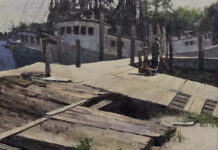
Mikel Wintermantel paints on copper plates instead of canvas or panels, and he’s been winning awards in plein air competitions. Why does he prefer to paint on copper?

Wintermantel’s setup
Wintermantel says it is the smoothness of the plate that makes the difference, although there are other positive qualities to copper as well. “I find the biggest advantage to be the expression that each brushstroke applied to copper produces,” he says. “Because of the smooth surface, I can get a lot more texture and direction in a single brushstroke with little effort. When I want to loosen up and cut loose, a copper substrate is the perfect remedy.”

“FOUR!” by Mikel Wintermantel, 2013, oil on panel, 8 x 10 in. “Painted plein air before, during and after a thunderstorm,” says the artist. This piece won second place and the People’s Choice award at the 1st annual Ellicottville, NY Plein Air Competition.
The New York artist prepares the copper plates for painting by simply sanding them briefly with an orbital sander. This gives the copper a bit more tooth, removes any scratches the plate may have, and removes any tarnish that may have built up on its surface. Wintermantel wraps the sanded copper plates carefully to keep the elements from degrading the surface before he can paint on it. Once a painting is done, he coats the copper with Liquin or cold wax varnish or another acid-free varnish to prevent corrosion.

“Gray Notes,” by Mikel Wintermantel, 2013, oil on copper, 5 x 11 in. This piece won Honorable Mention in the Finger Lakes Plein Air Festival, judged by David Lussier.

“A Quiet Place,” by Mikel Wintermantel, 2013, oil on copper, 5 x 7 in. Private collection
The nature of the metal is conducive to painting outdoors. “When plein air painting, copper is a perfect fit for the alla prima style,” Wintermantel says. “However, fast-drying oils can dry quickly enough for me to be able to employ my indirect method and layer over a previously painted section in a single outdoor session. I can choose to paint thinly and let the copper glow through, and I can scratch back paint layers to achieve sgraffito-like effects. Scratching all the way back to the copper affords a jewel-like glint in the details. The copper is unique enough on its own, but adding the glint and glow of the metal surface to the finished work allows it to stand out in a crowd.”

“Winter’s Warm Welcome,” by Mikel Wintermantel, 2010, oil on copper, 6 x 6 in. Private collection. This painting won third place in the inaugural 6″ Squared Competition.

“Coastal Vista,” by Mikel Wintermantel, 2011, oil on copper, 6 x 6 in. Private collection
Something about copper intimidates some artists. Maybe they are accustomed to the tooth of canvas, and they can’t imagine paint flowing very well on metal, or perhaps it’s just a tactile issue. Maybe it’s the glint and sheen that puts them off. Wintermantel has comforting words.

Sanding the copper panels
“At first copper can seem intimidating, but it is actually quite simple to use and a very forgiving surface,” says the artist. “With the right paint consistency and tools, you can achieve a limitless array of effects very quickly, before the light changes. The first time I tried it I likened it to painting on thin ice, but I soon realized how much fun it was.”




